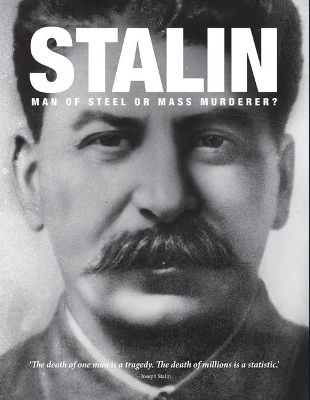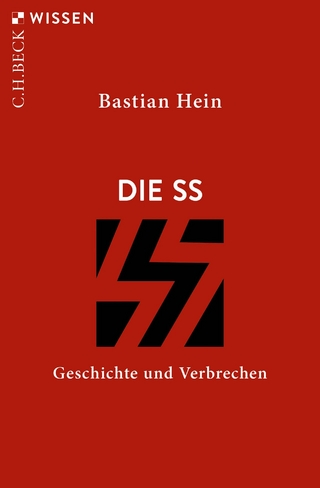
Stalin
Amber Books Ltd (Verlag)
978-1-78274-678-2 (ISBN)
- Titel ist leider vergriffen;
keine Neuauflage - Artikel merken
'I trust no one, not even myself.' – Joseph Stalin
Thug, armed robber, activist, revolutionary, tyrant – we know the headlines, we know about the atrocities, but what do we really know of the man at the heart of it all?
Stalin looks behind the image of the dictator and explores Ioseb Jughashvili’s Georgian childhood, his early political awakening, his criminal life, his rise within the Bolshevik party, and his times in exiles. It examines his personal life, including his two marriages and children from other relationships, his son’s attempted suicide and his second wife’s suicide. It charts his emergence as leader, his political ideology, his handling of famines, his secret police, gulags and murderous purges. It explores Stalin as war leader through the Civil War, Polish-Soviet War and World War II, and examines how he brought Eastern Europe behind the ‘Iron Curtain’ after 1945. It investigates the theory that the dictator might have been murdered by those close to him, and looks at just how quickly leading Soviet figures denounced the personality cult around him after his death. Stalin industrialised the Soviet Union and established the country as a world power – but at immense human cost.
Expertly written and illustrated with 180 colour and black-&-white photographs, paintings and artworks, Stalin tells the inside story behind one of the most significant figures of the 20th century.
Michael Kerrigan was educated at St. Edward’s College and University College, Oxford, England. He is the author of The History of Death, A Dark History: The Roman Emperors, Ancients In Their Own Words, World War II Plans That Never Happened, and American Presidents: A Dark History. He is a columnist, book reviewer, and feature writer for publications including the Scotsman and the Times Literary Supplement. Michael Kerrigan lives with his family in Edinburgh.
Introduction
Chapter 1: ‘A Very Sensitive Child’
Born into in Georgia to an alcoholic, violent cobbler father, Stalin was taken by his mother to live with a family friend, a priest, who got Stalin into Gori Church School. Stalin excelled academically but was unruly. By his late teens he had devoted himself to Marxism, attending secret workers’ meetings and, in 1899, abandoning the Spiritual Seminary.
Chapter 2: Red Dawn
Working as a meteorologist, Stalin encouraged workers across Tiflis to strike. He managed to evade arrest repeatedly and in November 1901, he was elected to the Tiflis Committee of the Russian Social Democratic Labour Party (RSDLP), a Marxist party founded in 1898. Organising demonstrations, he was arrested in 1902 and sentenced to three years exile in Siberia. Stalin made several escape attempts, ultimately succeeding in getting back to Georgia. He joins the Bolsheviks, disarmed local police and troops, raided government arsenals, and raised funds through protection rackets on large local businesses.
In 1906, he married his first wife, Kato Svanidze, and they had a son, Yakov. The year after that, Kato died of typhus. Stalin’s armed fundraising bank robbery caused the death of 40 people, none of them robbers.
He was sentenced to exile a number of times between 1909 and 1912, escaping each time back to St Petersburg. During one exile, he fathered his second, illegitimate, son, Konstanin. When not exiled, he secretly edited the relaunched Bolshevik daily newspaper, Pravda. He assumed the pseudonym K. Stalin – ‘Stalin’ meaning steel as he had become known as the ‘Man of Steel’. During one exile the 36-year-old revolutionary had a relationship with a 13-year-old village girl, a year under the age of consent at the time. They had a child that died in infancy, and two years later a son, Alexander.
Chapter 3: ‘Close the Ranks!’
Unfit for military service due to a childhood injury, Stalin moved to St Petersburg (Petrograd) after the February 1917 revolution, where he assumed control of Pravda and was appointed the Bolshevik representative to the Executive Committee of the Petrograd Soviet, an influential council of the city’s workers. In October 1917, the Bolsheviks staged a coup.
Stalin became part of Lenin’s government. He strongly supported Lenin’s formation of the Cheka security service and the subsequent Red Terror that it initiated. Lenin moved the government to Moscow and, with Stalin’s support, sued for peace in World War I, conceding large areas to the Central Powers, which angered many in Russia. Stalin married his secretary Nadezhda Alliluyeva.
Chapter 4: ‘The Collective Will’
Becoming General Secretary after Lenin had a stroke (1922) and ousting rivals, such as Trotsky, after Lenin’s death in 1924. Dekulakisation, collectivisation, and industrialisation: 1927–1931. Siezing grain supplies off kulaks (land-owning peasants), before kulaks themselves were exiled.
Chapter 5: ‘Life Has Become More Joyous’
Famine (1932–33) – between five and seven million people died in Ukraine, North Caucasus and other parts of the USSR. Some have suggested that the famine was deliberately exacerbated by Stalin to destroy the Ukrainian nation.
Foreign affairs – Stalin initiated confidential communications with Hitler in October 1933, shortly after the latter came to power in Germany. Stalin admired Hitler, particularly the latter’s manoeuvres to remove rivals within the Nazi Party.
The Great Terror – conflicting behaviour of releasing former prisoners on the one hand and ordering executions on the other. Increase in state repression. NKVD permitted to act without trial. Show trials, arrests of former opponents in the Communist Party. Assassinations, including of Trotsky. Great Purge. During these years, approximately 1.6 million people were arrested. 700,000 were shot, and an unknown number died under NKVD torture. The Terror had damaged the Soviet Union's reputation abroad, particularly among previously sympathetic leftists.
Chapter 6: ‘Victory Will Be Ours’
August 1939: Non-Aggression Pact with Germany.
Invading Poland, officially to restore order amid the collapse of the Polish state after the German invasion. Invading Baltics, resistance from Finland. Katyn massacre of April and May 1940, in which around 22,000 members of the Polish armed forces, police, and intelligentsia were executed.
June 1941: Operation Barbarossa – German invasion of Soviet Union, which Stalin had been warned about but was still surprised by when it happened. Moscow bombed and near to evacuation.
Encircling the Wehrmacht at Stalingrad in 1942-43 and the war beginning to turn in Soviet favour.
1944: As the Red Army reconquered the Caucasus and Crimea, various ethnic groups living in the region – the Kalmyks, Chechens and Crimean Tatars – were accused of having collaborated with the Germans. Using the idea of collective responsibility as a basis, Stalin deported the majority of their populations to Central Asia and Siberia.
Chapter 7: ‘Sweeping Forward’
Returning soldiers passed through filtration camps to weed out any whose experience in the Capitalist West might have led them to become traitors. More than a million were sent to labour camps. The NKVD recorded that between 26 and 27 million Soviet citizens had been killed in the war, with millions more being wounded, malnourished, or orphaned.
‘Iron Curtain’ descends across Eatern Europe. Berlin Blockade.
Tension within the Eastern Bloc – Stalin ordered assassination attempts on Yugoslavia’s Jozip Tito. Bringing Communism to Poland was, said Stalin, like ‘trying to saddle a cow’.
Chapter 8: The Savage Saviour
A stroke led to his death in March 1953. A possibility that he was murdered. The same month, Malenkov, a key Central Committee figure, denounced the Stalin personality cult. Stalingrad was renamed Volgograd. The system of collective leadership was restored, and measures introduced to prevent any one member attaining autocratic domination again. The new leaders sought rapprochement with Yugoslavia and a less hostile relationship with the US, pursuing a negotiated end to the Korean War in July 1953. In 1956, Khruschev denounced Stalin for both his mass repression and his personality cult. In October 1961, Stalin's body was removed from the mausoleum and buried in the Kremlin Wall Necropolis next to the Kremlin walls, the location marked only by a simple bust.
Bibliography
Index
| Erscheinungsdatum | 02.10.2018 |
|---|---|
| Zusatzinfo | 180 photos and artworks; 180 Illustrations, unspecified |
| Verlagsort | London |
| Sprache | englisch |
| Maße | 192 x 250 mm |
| Gewicht | 950 g |
| Themenwelt | Literatur ► Biografien / Erfahrungsberichte |
| Literatur ► Briefe / Tagebücher | |
| Sachbuch/Ratgeber ► Geschichte / Politik | |
| Geschichte ► Allgemeine Geschichte ► 1918 bis 1945 | |
| Geschichte ► Teilgebiete der Geschichte ► Militärgeschichte | |
| ISBN-10 | 1-78274-678-1 / 1782746781 |
| ISBN-13 | 978-1-78274-678-2 / 9781782746782 |
| Zustand | Neuware |
| Haben Sie eine Frage zum Produkt? |
aus dem Bereich


